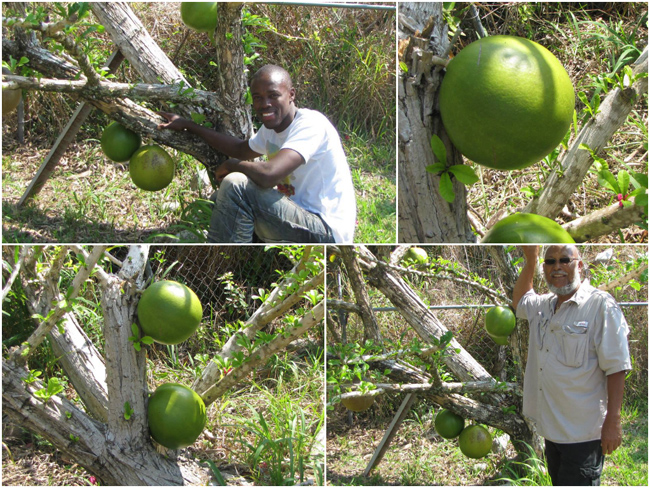|
|

|

|
 |
|
Last Updated: Feb 6, 2017 - 2:32:04 PM |

This is me checking out Mr. Darville's (botton right) calabash tree in his Grand Bahama backyard.
|
This, I am writing for people that have forgotten a piece of their history; but I have taken special care in writing this for the Urban Renewal Center in Lewis Yard, a settlement in Grand Bahama Island where I live.
I recently spoke with the ladies there and told them of the treasure that they have on the property, and how they should cherish it. I know it doesn't seem like much right now but in the coming years this tree will be worth a lot and because the next generation is far more creative than we can imagine. I am speaking of the "Calabash Tree" and their gourds which could very well become a pivotal role in our economy. These gourds were used in ancient times to carry water: and from what I have gathered they are like a mini refrigerator.
As a matter of fact it is said that this tree is one of the first cultivated trees on the planet. It was grown because of its ability to keep water very cool for hours in the hot sun. During long journeys it was also used to carry sugar canes.
I learned about this tree last year while visiting Mr. Joseph Darville and he gave me more than enough information to be able to share with you. Although I may not remember everything; I hope that, the little that I do know, can help you better appreciate this tree.
The picture you see here was taken on Mr. Darville's property and the tree is so exquisite and beautiful, it took me a moment to take it all in. It stands as a testament of the Creator's genius and His love for man, to understand its beauty and purpose.
To Mr. Darville, one can tell it holds a significant value to him. While growing up in Long Island the Calabash gourd was used to store water for him and his family when they went fishing, and he had taken it upon himself to begin propagation of his plants throughout Long Island. His wife today uses it to create beautiful artwork and you can tell how proud they are of the Calabash tree. I truly respect them for the work that they have done in helping men like myself become more knowledgeable about our history.
We tend to ignore trees today, but not so long ago these were the backbone of our development to modern civilization. Without these plants we may very well have not made the journey to the new world, so that makes this relevant to our future. I know we may not need them anymore but we should respect them for what they offer and have offered us in the past.
My dream is to see every household throughout the Bahamas with a Calabash tree because it is still versatile even in today.
What can be done with the calabash you might ask; well plenty. You can make bowls with the gourds and almost any hand-crafting like bags, but I am in awe when I see people use the gourd to make some musical instruments and that's why it's so important. It has kept us alive and helped us to make music to satisfy our souls.
There are different varieties, but they all hold the same qualities. The beauty to me is in its flower, and how only a bat can pollinate this tree, and they will fly from the caves to find it and yes, only a bat can pollinate it!
The Calabash is so ominous, it was used everywhere from Africa, to the Middle east and China but Haiti I think may have been the only county that placed a national value on it. In fact King Henry Christopher of Haiti, made it the National Currency of the country and the government owned everyone. The Haitian Gourge which is the term used for their dollar, as it stands today is really referring to the gourd. It was use in the Haitian's Voodoo religion, which makes sense for witch doctors of that era, since the plant does have a lot of medicinal purposes as well: The leaves were use to treat diarrhea, fever and constipation.
So today I have this tree growing in my backyard and I tell all now of the stories about this plant; that it may last into the next generation and although it is not a plant that we can eat, it does hold some value to our past, and therefore we should respect it.
About the Author:
Luckner Timothee is a backyard Farmer in Grand Bahama since starting
his garden a few years ago he has wooed his friends with his produce and
creative farming ideas. He continually learns from his friends and
family about the process of farming and the struggles that a farmer goes
through daily. He is now working on a Web show called “Let’s Grow
Bahamas” to be released on “Grand Bahama Backyard Farmers”. He is
attending seminars in order to meet other farmers around the world and
to further his knowledge about Farming. To contact Luckner Timothee
email him at:
bahamasfarmers@live.com

© Copyright 2014 by thebahamasweekly.com
Top of Page
|
|
 |

|
